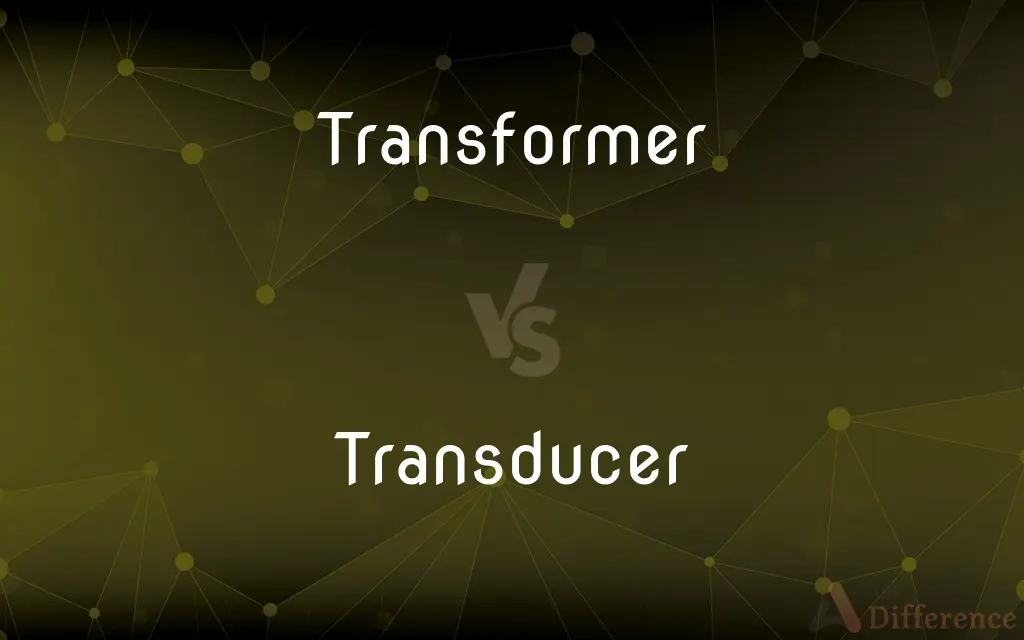Transformer vs. Transducer — What's the Difference?
By Tayyaba Rehman & Maham Liaqat — Updated on March 19, 2024
A transformer is an electrical device that transfers electrical energy between two or more circuits through electromagnetic induction. A transducer, converts one form of energy into another, facilitating the measurement or control of pysical quantities.

Difference Between Transformer and Transducer
Table of Contents
ADVERTISEMENT
Key Differences
Transformers play a crucial role in electrical power distribution, allowing for efficient transmission of electricity over long distances by stepping up (increasing) or stepping down (decreasing) voltage levels as needed, without changing the total electrical power. Conversely, transducers are key components in various systems and devices, converting physical forces, such as pressure, temperature, and sound, into electrical signals or vice versa.
While transformers operate on the principle of electromagnetic induction, relying on alternating current (AC) to induce voltage changes across coils, transducers function on the basis of various physical principles, depending on the type of energy conversion required. For example, piezoelectric transducers convert mechanical pressure into electrical signals, thermocouples convert temperature differences into voltage, and photovoltaic cells convert light into electricity.
Transformers are essential for the practical use of electrical energy, ensuring that electricity is delivered to homes and businesses at usable voltage levels. They are a fundamental part of the electrical grid, substations, and various electrical appliances. In contrast, transducers are ubiquitous in everyday technology, including microphones, loudspeakers, sensors, and medical imaging devices, bridging the gap between physical phenomena and electronic systems by allowing non-electrical quantities to be processed electronically.
The distinction between transformers and transducers lies not only in their function but also in their application. Transformers are specialized for electrical energy management within power systems, focusing solely on voltage transformation to optimize power delivery and consumption. Transducers, however, serve a broader purpose across multiple disciplines, including but not limited to electrical, mechanical, and acoustic fields, facilitating the interaction between electrical systems and the physical world.
Understanding the differences between transformers and transducers illuminates the varied ways in which electrical principles are leveraged to manage energy and convert physical phenomena into useful data, reflecting the diversity and complexity of modern technological and scientific applications.
ADVERTISEMENT
Comparison Chart
Function
Transfers electrical energy between circuits, altering voltage levels.
Converts one form of energy into another.
Principle
Operates on electromagnetic induction.
Operates based on various physical principles for energy conversion.
Main Use
Electrical power distribution and voltage regulation.
Measurement, monitoring, and control of physical phenomena.
Application Examples
Electrical grids, substations, power adapters.
Microphones, thermocouples, pressure sensors, medical imaging devices.
Energy Types Involved
Electrical to electrical (voltage changes).
Various, including mechanical to electrical, thermal to electrical, etc.
Compare with Definitions
Transformer
Transformers are integral to electrical grids and appliances for voltage adjustment.
Every power adapter includes a transformer to adjust voltage to safe levels.
Transducer
Transducers are crucial in medical, industrial, and consumer electronics.
Ultrasound machines use transducers to convert sound waves into images of the body's interior.
Transformer
It operates on alternating current to induce voltage changes without altering power.
Transformers are key in minimizing losses during power distribution.
Transducer
It enables the electronic measurement of non-electrical phenomena.
Piezoelectric transducers in microphones convert sound waves into electrical signals.
Transformer
They ensure electricity is delivered efficiently across distances.
Long-distance transmission lines use transformers to step up voltage and reduce energy loss.
Transducer
They facilitate the control and interaction with physical systems.
Pressure transducers in HVAC systems help maintain optimal environmental conditions.
Transformer
Essential for maintaining usable voltage levels for consumers.
Transformers at substations ensure the electricity entering homes is at the correct voltage.
Transducer
Versatile in application, ranging from sensors to energy conversion devices.
Photovoltaic cells are transducers that convert sunlight into electrical energy.
Transformer
A transformer is a device that modifies the voltage of electrical power in transmission.
The transformer outside our building steps down the high voltage for residential use.
Transducer
A transducer converts physical quantities into readable electronic signals.
The temperature sensor, a type of transducer, converts heat into electrical signals for monitoring.
Transformer
A transformer is a passive component that transfers electrical energy from one electrical circuit to another circuit, or multiple circuits. A varying current in any one coil of the transformer produces a varying magnetic flux in the transformer's core, which induces a varying electromotive force across any other coils wound around the same core.
Transducer
A transducer is a device that converts energy from one form to another. Usually a transducer converts a signal in one form of energy to a signal in another.Transducers are often employed at the boundaries of automation, measurement, and control systems, where electrical signals are converted to and from other physical quantities (energy, force, torque, light, motion, position, etc.).
Transformer
One that transforms:a transformer of recruits into soldiers.
Transducer
(Physics) A substance or device, such as a piezoelectric crystal, microphone, or photoelectric cell, that converts input energy of one form into output energy of another.
Transformer
A device used to transfer electric energy from one circuit to another, especially a pair of multiply wound, inductively coupled wire coils that effect such a transfer with a change in voltage, current, phase, or other electric characteristic.
Transducer
(Biology) Something, such as a receptor in a cell membrane, that transmits a signal within a cell or from the exterior of a cell to its interior.
Transformer
Something that transforms, changing its own or another thing's shape.
Transducer
A device that converts energy from one form into another.
Transformer
(electrical engineering) A static device that transfers electric energy from one circuit to another by magnetic coupling. Their main use is to transfer energy between different voltage levels, which allows choosing most appropriate voltage for power generation, transmission and distribution separately.
Transducer
(computing theory) A state machine that generates output based on a given input.
Transformer
(machine learning) A neural network architecture that relies on self-attention mechanisms.
Transducer
An electrical device that converts one form of energy into another
Transformer
Alternative case form of Transformer
Transformer
One who, or that which, transforms. Specif. (Elec.), an apparatus for producing from a given electrical current another current of different voltage.
Transformer
A toy consisting of a figure or representation of an object, constructed of interlocking parts in such a way that a series of turning or twisting motions of the parts can transform the object from one type of object to a different type of object, such as from an animal to an automobile.
Transformer
An electrical device by which alternating current of one voltage is changed to another voltage
Common Curiosities
What is the primary function of a transformer?
The primary function of a transformer is to change the voltage level of electrical power in a circuit, facilitating efficient power transmission and distribution.
What types of energy conversions can transducers perform?
Transducers can perform various energy conversions, including mechanical to electrical, thermal to electrical, acoustic to electrical, and more.
Can a transformer convert DC to AC or vice versa?
No, transformers work with alternating current (AC) to change voltage levels; they cannot directly convert DC to AC or vice versa.
Is a microphone considered a transducer?
Yes, a microphone is a transducer because it converts sound waves (acoustic energy) into electrical signals.
What are some common applications of transducers?
Common applications include measuring temperature with thermocouples, converting sound with microphones, and visualizing the interior of the body with ultrasound imaging devices.
How does a transducer differ from a transformer?
A transducer converts one form of energy into another, often turning physical quantities into electrical signals, whereas a transformer solely modifies electrical voltage levels.
Where are transformers commonly used?
Transformers are commonly used in the electrical power distribution network, in substations, and within electrical appliances to adjust voltage.
Why are transformers important in electrical grids?
Transformers are crucial for stepping up voltage to reduce energy loss during long-distance transmission and stepping down voltage for safe usage in residential and commercial settings.
How do transducers contribute to technology and science?
Transducers enable the measurement, monitoring, and control of physical phenomena, facilitating advancements in technology and science by allowing for precise data collection and analysis.
What role do transducers play in environmental monitoring?
Transducers, such as temperature and pressure sensors, play a critical role in monitoring environmental conditions, contributing to weather forecasting, climate research, and habitat preservation.
Share Your Discovery

Previous Comparison
Gorilla vs. Panda
Next Comparison
Dextro vs. LevoAuthor Spotlight
Written by
Tayyaba RehmanTayyaba Rehman is a distinguished writer, currently serving as a primary contributor to askdifference.com. As a researcher in semantics and etymology, Tayyaba's passion for the complexity of languages and their distinctions has found a perfect home on the platform. Tayyaba delves into the intricacies of language, distinguishing between commonly confused words and phrases, thereby providing clarity for readers worldwide.
Co-written by
Maham Liaqat













































